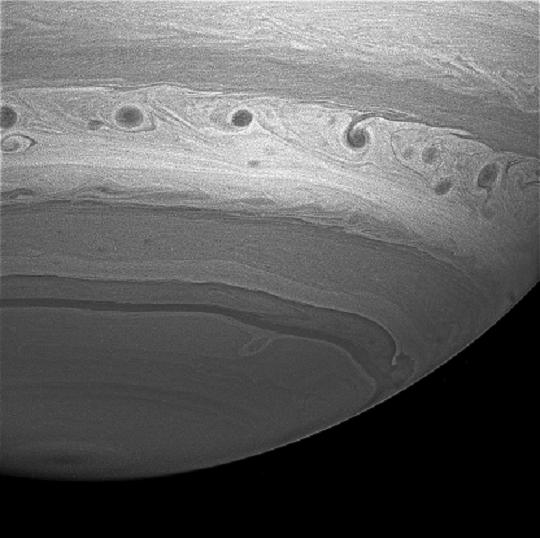Recent images from the Cassini-Huygens spacecraft have
shown that the north pole of Saturn is similar to the south pole:
both locations are home to spinning vortices on a colossal scale. In
the South, say mission specialists, a
persistent whirlpool of clouds demonstrates "upwelling" of heat
from deep beneath the planet's frigid outer atmosphere.
A
new image from Cassini reveals regions beneath the clear surface
atmosphere, rising and condensing into puffy clouds similar to those
in a hurricane on Earth. The "eye" of the southern vortex is said to
indicate the colder surface gases are being drawn down into the warm
interior, completing a heat transfer mechanism. Why the cyclonic
rotation is confined to the south pole is not understood, since the
hurricanes on Earth draw their power from warm water as they
move across the ocean.
Andrew Ingersoll from
Caltech said: "Itís like seeing into the eye of a hurricane. Itís
surprising. Convection is an important part of the planetís energy
budget because the warm upwelling air carries heat from the
interior. In a terrestrial hurricane, the convection occurs in the
eyewall; the eye is a region of downwelling. Here convection seems
to occur in the eye as well."
In the North a
hexagonal formation outlining a central maelstrom remains
unexplained. Despite wind speeds of 530 kilometers per hour inside
the hexagon and 500 kilometers per hour outside,
the hexagon does not appear to move except with the planet's
rotation. The north polar hexagon was seen in perspective by both
Voyager probes as they flew by the gas giant in November 1980
and then in August 1981, so it is a long-lived phenomenon. The
imaging team continues to analyze data in hopes of finding a method
by which convection can arrange and maintain a six-sided formation
in a spinning cloud layer.
To this day NASA
scientists have been unable to come up with an explanation for
another one of Saturn's strange features, the ultraviolet auroral
light seen at mid-latitudes in the atmosphere. The ultraviolet light
is also accompanied by x-rays glowing from the ring plane and from
regions within "Storm Alley" shown at the top of the page. Since it
is electrons and positive ions that cause aurorae on Earth, and
those are always at higher latitudes, Voyager analysts entered the
observation into Saturn's "big book of puzzles," in hopes that
future missions will be able to figure it out.
A particularly
significant entry in that big book are the giant
white spots that also appear in mid-latitudes on Saturn. Another
is the so-called "dragon storm" that Electric Universe theorist
Wal Thornhill associated with the white spots. The massive
"thunderstorm," as the Cassini team describes it, has remained fixed
in one location since 2004, creating winds in excess of 1700
kilometers per hour and continuous discharges of lightning 1000
times more powerful than anything on Earth.
Wal Thornhill wrote:
"Like Jupiter's Great Red Spot, the dragon storm on Saturn seems to
be a long-lived storm center that occasionally flares up. The
clock-like regularity of the radio emissions from storms on Saturn
is used to judge the great planet's actual rotation rate beneath the
clouds. But this behavior is enigmatic. Why should an electrical
storm attach itself to a particular spot on a planet's surface,
particularly when that surface is thought to be liquid?"
These inexplicable hot
storms on Saturn, the polar vortices with their (apparently) stable
configurations, megalightning, ultraviolet light and x-rays from low
latitudes, and winds blowing at a thousand kilometers per hour point
to a single cause for all the effects. Add to those observations the
ďspokesĒ
of the ring system, the
plasma torus around Saturn, as well as Saturnís radiation belt,
and we are left with an electrically active planet that is part of a
circuit connecting the Sun and its plasma sheath, the heliopause.
By Stephen Smith







